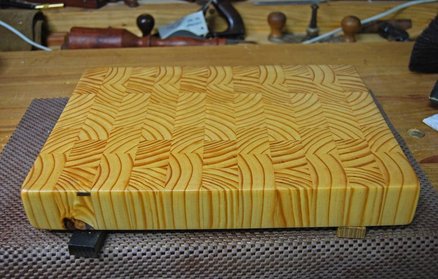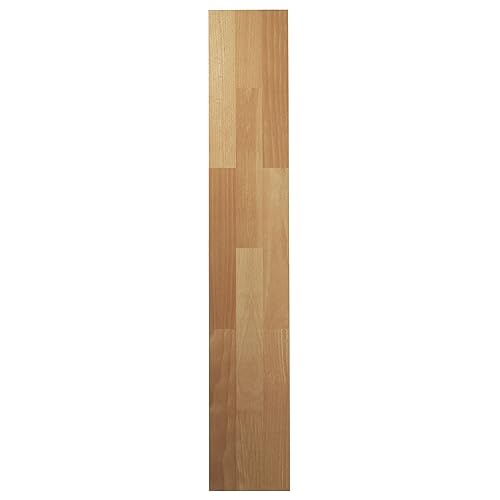Are you contemplating making a cutting board from pine and are not sure if it will be adequate for the task? This blog post will explore the viability of using pine for a cutting board and provide some tips on making the most out of this wood.
Note that it’s important to select the right pine type and follow the proper steps for finishing and sealing the board to have a durable cutting board.
So can you use pine for a cutting board? spoiler alert: It’s doable! Keep reading to learn more.
Can You Use Pine for a Cutting Board?
Yes, you can use pine for cutting boards, but it’s not the best type of wood to use for this purpose. Pine is softwood, which means it will be more prone to scratches and nicks than harder woods like maple or oak. Pine is also more absorbent than other types of wood, so it will need to be sealed properly to prevent warping and cracking.
What is Pine?
Pine is a type of evergreen tree that belongs to the Pinaceae family. There are around 115 species of pine trees, and they are native to the Northern Hemisphere.
Pine trees can grow up to 30 meters (98 feet) tall and have thin, needle-like leaves arranged in pairs. The pinecone is the fruit of the pine tree, and it contains the seeds of the tree.
Pine trees are commonly used in construction, furniture-making, and paper production. Pine wood is softwood that is light in color, ranging from yellow to pale brown. The pine wood grain is straight or slightly wavy and has a coarse texture.
Pine is a popular type of wood for making rustic-style furniture and decor. It’s also often used as a cheaper alternative to hardwood floors.
Pine is also a source of turpentine, rosin, and pine oil used in cleaning products, paints, and varnishes.
Types of Pine
Several types of pine are commonly used in construction and furniture-making, including:
- Sugar pine (Pinus lambertiana)
- Ponderosa pine (Pinus ponderosa)
- Lodgepole pine (Pinus contorta)
- White pine (Pinus strobus)
Why Use Pine for Cutting Boards?
Pine is not a good wood for cutting board. But it can be used if properly sealed and cared for. Pine is a softer wood, so it will easily scratch than other types of wood.
Pine is also more absorbent than other types of wood, so it will need to be sealed properly to prevent warping and crack.
If you decide to use pine for your cutting board, select a rot-resistant pine, such as sugar pine or white pine. You’ll also want to make sure the pine is properly sealed to prevent warping and crack.
What to Look for in Wood for Wooden Chopping Boards
When shopping for wood for your cutting board, keep a few things in mind.
Cost
The prices of different woods can vary greatly, so it’s important to consider your budget when selecting wood for your cutting board.
Pine is one of the more affordable options, but it’s not the best quality. If you’re looking for a high-quality cutting board that will last, you’ll need to spend more on harder wood like oak, maple or cherry.
Porosity
Choose wood with invisible pores, making the cutting board resistant to staining and warping. Conversely, wood with open pores is more likely to absorb liquids, which can cause the board to warp or crack.
Maple and oak are good options for cutting boards because they have closed pores. Pine is also a good option as long as it’s properly sealed.
Conditioning
Make sure the wood is properly conditioned before use. Conditioning the wood helps to prevent splitting and shrinking. To condition the wood, soak it in a mixture of 1 part mineral oil and 2 parts beeswax.
Then, rub the board with the beeswax mixture until evenly coated. Let the board sit for 24 hours, then buff it with a clean cloth.
Toxicity
Avoid woods that are toxic to humans, such as yew and raintree. These woods can release toxins that can be harmful if ingested.
Janka hardness rating
The hardness of the wood is important to consider because it will determine how durable your cutting board is. Harder woods like maple and oak are more durable and less likely to scratch or warp over time.
Softer woods like pine are more prone to these problems. If you decide to use pine for your cutting board, select a rot-resistant variety and take care to seal and condition the wood properly.
Best Wood for Cutting Board
Marple
- Tivoli Wood-Look Floor Planks: Transform your floor for a low cost and no hassle with the Tivoli Vinyl Floor Planks. These planks can be used in any room in your home. No messy glue or adhesives needed. Includes 10 vinyl planks.
- Dimensions: Each plank measures 6 inches x 36 inches and 2.0mm thick. There are 10 planks per box, which will cover 15 square feet.
- Peel ‘N’ Stick: The Tivoli Floor Planks feature easy DIY installation. Simply peel and stick the planks to a flat and dry surface to give your home a brand-new look.
This hardwood is available in various colors, making it a good option for cutting boards. It’s also less likely to warp or crack than other types of wood.
Teak
- You are buying 6 Teak Boards
- Kiln dry
- May need sanding to get smoother for your use
It’s naturally water-resistant, making it a good choice for cutting boards. It’s also strong and durable so that it won’t scratch or warp easily.
Walnut
- Beautiful Grain
- Perfectly Kiln Dried
- Guaranteed to clean up 100% at 1-3/4"
It’s a hardwood that’s less likely to warp or crack. It also has a high oil content, making it resistant to water and staining.
Cherry
- Beautiful Grain
- Two sides sanded to 3/4" thickness
- Kiln dried
It’s one of the hardest woods, making it a good choice for cutting boards. Cherry is also less likely to stain or absorb odors.
What Wood is not Good to Use in a Cutting Board?
Ash- Ash is a hardwood, porous absorbent likely to warp, shrink or crack easily.
Birch- Birch is a hardwood lumber, but it tends to split and crack easily.
Cedar- It’s a softwood that’s prone to warping and cracking. Here’s more on cedar cutting board.
Hemlock- It’s softwood that stains easily and is also absorbent.
Whitewood- While whitewood is generally considered softer and less durable than hardwoods, it might not be the best choice for cutting boards due to its potential for easy damage and wear. (See the battle of Pine vs Whitewood)
Red oak- Red oak is not good for cutting boards. It’s a hardwood with open pores that make it more likely to warp or crack.
Yew- Yew is a hardwood, but it’s toxic to humans and should not be used in making cutting boards or anything edible.
Desiring that classic oak aesthetic for your pine? Look no further – we’ve got the secret to turning your pine into a stunning oak look.
Advantages and Disadvantages of Pine
Pros
- It is easy to work with
- It is cheaper than other types of wood
- A pine tree grows quickly compared to other types of wood
- It is easy to stain and work with
- Its grains and patterns are aesthetically pleasing
Cons
- It yellows over time
- It needs to be preserved to be protected from rot
- It is likely to shrink, swell or warp
- It is not weatherproof
Is Pine safe for Food?
Yes, pine trees are safe for food when the pinecones, needles, bark, and sap are removed. The inner flesh of the pinecone is where the majority of the toxins are found.
Once this is removed, the pinecone can be roasted and eaten as a nutritious snack. The needles can also make tea, which is high in Vitamin C.
The bark can be used as a flavoring agent in cooking but should not be consumed independently. Finally, the sap can be distilled into an essential oil with culinary applications.
While pine trees are safe for food, it’s important to note that some people may be allergic to them. Therefore, anyone with a known allergy to Pineapple should avoid consuming it.
What can You Build with Pine?
Pine is an affordable and versatile option for building material, making it a top choice for do-it-yourself projects and home renovations. For example, you can use pine to:
- Making homemade boards for a bulletin board or other project
- Creating custom picture frames for photos or artwork
- Building a simple bookshelf or other types of a shelving units
- Construct a coffee table, end table, or nightstand
- Tailoring it to your style and preferences
- Updating an old dresser with new drawer pulls made from pine wood. (See how to make wood drawers slide easily)
FAQs
Can I use pine wood for a butcher block?
Yes, you can use pine wood for a butcher block. However, it is important to keep in mind that pine wood is softer than other types of wood, so it may not be as durable. Additionally, the resins in pinewood can release a strong flavor and scent, so you may want to consider using a sealant or oil to help protect the wood and minimize the odor.
Is pine good for charcuterie boards?
Yes, pine boards are a great choice for charcuterie boards because the wood resin helps preserve and protect the meat. Pine also has a nice flavor that pairs well with cured meats and cheeses.
Is pine wood good for shelving?
The suitability of pine wood for shelving depends on the specific application and the surrounding conditions. Opting for poplar or pine is a good decision if you desire a natural aesthetic. Yet, in damp environments, pine wood might be prone to warping or decay. Moreover, when it comes to durability, pine wood could be less robust than other woods, potentially leading to sagging with heavy loads.
Is pine wood hard to cut?
It depends on the type of pine wood. Some types of pine wood are harder to cut than others. Keep in mind that the softer the wood, the more likely it is to split when you’re cutting it. So if you’re using soft pine wood, it will be harder to cut than hard pine wood.
Recommended Reading: Is Acacia Wood Good For Cutting Boards?
So, Can You use Pine for a Cutting Board?
Yes. Pine can be used for cutting boards, but it’s not the best type of wood to use. Pine is softer than other types of wood, so it will scratch easily.
Pine is also more absorbent than other types of wood, so it needs to be properly sealed. Now that you know more about pine, you can decide if it’s the right type of wood for your next project.





